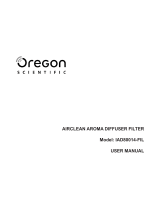4
YOUR SAFETY AND THAT OF OTHERS IS
VERY IMPORTANT.
This manual and the appliance itself provide
important safety warnings, to be read and
observed at all times.
This is the alert symbol, relevant to safety,
which warns of potential risks to the user and
others.
All safety messages will be preceded by the alert
symbol and the following terms:
Indicates a hazardous situation which, if not
avoided, will cause serious injury.
Indicates a hazardous situation which, if not
avoided, could cause serious injury.
All safety messages specify the potential
hazard/warning to which they refer and indicate
how to reduce the risk of injury, damage and
electric shock resulting from incorrect use of the
appliance.
Carefully observe the following instructions:
• Installation and maintenance must be carried
out by a specialised technician, following the
manufacturer's instructions and in compliance
with current local safety regulations.
Do not repair or replace any part of the
appliance unless specifically required in the user
manual.
• The appliance must be disconnected from the
power supply before carrying out any
installation work.
• Earthing of the appliance is compulsory. (Not
necessary for class II hoods identified by the
symbol on the dataplate).
• The power cable must be long enough for
connecting the appliance to the power supply.
• Do not pull the power cable to unplug the
appliance.
• The electrical components must not be
accessible to the user after installation.
• The hood has safety switches that prevent its
operation when the front filter panel is
unhooked.
• Do not touch the appliance with any wet part of
the body and do not operate it when barefoot.
• The appliance is not intended for use by people
(children included) with physical, sensory or
mental impairment or without experience and
knowledge of the appliance, unless supervised
or previously instructed in its use by those
responsible for their safety.
• Do not repair or replace any part of the
appliance unless specifically indicated in the
manual.
All other maintenance services must be carried
out by a specialised technician.
• Children must be supervised to ensure they do
not play with the appliance.
• During installation, be careful not to damage
electrical connections.
• Ventilation ducts must always discharge to the
outside.
• Exhaust air must not be vented through a flue
used for removal of fumes produced by gas
combustion appliances or other combustible
materials, but must have a separate outlet. All
the national regulations on air discharge must be
observed.
• If the hood is used together with other
appliances operating on gas or other fuels, the
negative pressure in the room must not exceed
4 Pa (4 x 10-5 bar).
For this reason, make sure the room is
adequately ventilated.
• Do not modify any connection on the electrical
boards and wiring.
• When handling the hood, keep hands outside
the range of the extraction panel.
• The Manufacturer declines any liability for
improper use or incorrect setting of the
controls.
• Regular maintenance and cleaning will ensure
proper operation and good performance of the
appliance.
Clean dirty surfaces often to prevent grease
build up.
• Failure to carry out correct hood cleaning or
filter maintenance involves the risk of fire.
• Do not cook food flambé because the use of a
naked flame could cause a fire.
• Make sure the lamps are cold before touching
them.
• Do not use or leave the hood without its lamps
correctly installed - risk of electric shock.
• The hood is not a support surface, therefore do
not place any objects on it or overload it.
• Wear work gloves for all installation and
maintenance operations.
DANGER
WARNING
Important instructions for safety
















